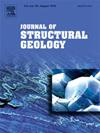自然变形的多矿物岩石提供定量流变学信息
IF 2.9
2区 地球科学
Q2 GEOSCIENCES, MULTIDISCIPLINARY
引用次数: 0
摘要
多相岩比单矿物岩更常见,但它们的流变学不太受约束。我们利用应变标记、矿物含量的自然变化和微观结构观察相结合,量化了澳大利亚昆士兰州伊萨因利尔山东褶皱带形变和变质浊积岩序列的流变学。在露头尺度上,富石英脉体的连续偏转记录了与矿物学变化相对应的剪切应变大小变化。在富含黑云母和白云母(层状硅酸盐)的域,相对于地层较低的富含石英和长石(石英长)的域,记录到较大的挠度(较高的应变)。对代表性浊积岩层序岩心的x射线衍射分析表明,随着地层高度的增加,云母含量增加(12 - 52%),石英和长石含量减少(86 - 38%)。电子后向散射衍射分析显示,石英中存在可测量的晶体学优先取向,表明石英场域存在晶内变形,而邻近的层状硅酸盐域不存在这种变形。背散射电子图像记录了层状硅酸盐领域的溶-析出蠕变和晶界滑动的证据,表明变形是由晶间过程调节的。尽管两个区域记录的应力差相似,但根据剪切应变比计算的相对应变率随着云母含量的增加而增加。一个表征层状系统中应变分配的概念模型定量地证明了体变形对矿物域的相对厚度和粘度比的依赖。本文章由计算机程序翻译,如有差异,请以英文原文为准。
Naturally deformed polymineralic rocks provide quantitative rheological information
Polyphase rocks are more common than monomineralic rocks, but their rheologies are less well constrained. We utilize a combination of strain markers, natural variations in mineral content, and microstructural observations to quantify the rheology of deformed and metamorphosed turbidite sequences from the Eastern Fold Belt in the Mount Isa Inlier, Queensland, Australia. At the outcrop scale, continuous deflection of quartz-rich veins records changes in shear strain magnitude that correspond to variations in mineralogy. Larger deflections (higher strains) are recorded in biotite- and muscovite-rich (phyllosilicate) domains relative to stratigraphically lower quartz- and feldspar-rich (quartzofeldspathic) domains. X-ray diffraction analyses of cores from a representative turbidite sequence show an increase in mica content (12–52 %) and a decrease in quartz and feldspar content (86–38 %) with increasing stratigraphic height. Electron backscatter diffraction analyses show a measurable crystallographic preferred orientation in quartz, indicating intracrystalline deformation in a quartzofeldspathic domain, which is absent in the adjacent phyllosilicate domain. Back-scattered electron images document evidence of solution-precipitation creep and grain-boundary sliding in a phyllosilicate domain, indicating deformation was accommodated by intercrystalline processes. Despite similar differential stress recorded by both domains, relative strain rates, calculated from ratios of shear strain, increase with mica content. A conceptual model that characterizes strain partitioning in layered systems quantitatively demonstrates the dependence of bulk deformation on the relative thicknesses and viscosity ratios of mineralogical domains.
求助全文
通过发布文献求助,成功后即可免费获取论文全文。
去求助
来源期刊

Journal of Structural Geology
地学-地球科学综合
CiteScore
6.00
自引率
19.40%
发文量
192
审稿时长
15.7 weeks
期刊介绍:
The Journal of Structural Geology publishes process-oriented investigations about structural geology using appropriate combinations of analog and digital field data, seismic reflection data, satellite-derived data, geometric analysis, kinematic analysis, laboratory experiments, computer visualizations, and analogue or numerical modelling on all scales. Contributions are encouraged to draw perspectives from rheology, rock mechanics, geophysics,metamorphism, sedimentology, petroleum geology, economic geology, geodynamics, planetary geology, tectonics and neotectonics to provide a more powerful understanding of deformation processes and systems. Given the visual nature of the discipline, supplementary materials that portray the data and analysis in 3-D or quasi 3-D manners, including the use of videos, and/or graphical abstracts can significantly strengthen the impact of contributions.
 求助内容:
求助内容: 应助结果提醒方式:
应助结果提醒方式:


